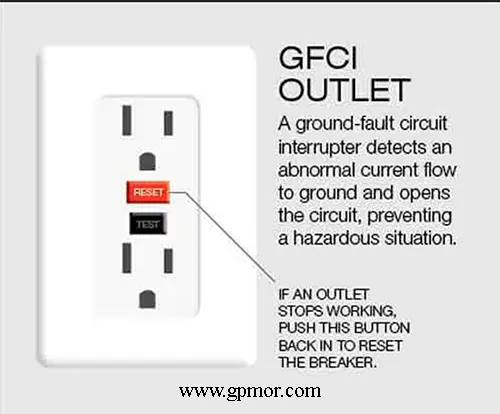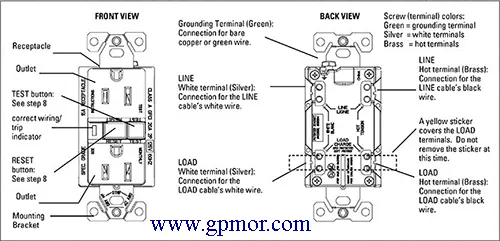Table of Contents
Will GFCI work with 2 wire? The question of whether a Ground Fault Circuit Interrupter (GFCI) can work on a two-wire circuit often arises, especially during electrical inspections or renovations of older homes. This blog aims to address this question comprehensively, integrating opinions from various discussions and providing a detailed understanding of how GFCIs function within two-wire circuits.
Understanding GFCI Functionality

To begin with, it’s crucial to understand how a GFCI works. A GFCI is designed to protect people from electrical shock by detecting differences in the electrical current between the hot and neutral wires. If the GFCI senses an imbalance greater than 5 milliamps (mA), it trips the circuit, cutting off the flow of electricity. This tripping mechanism does not rely on a grounding wire, which is a common misconception.
GFCI in a 2-Wire Circuit

A two-wire circuit consists of a hot wire and a neutral wire, but lacks a grounding wire. Despite the absence of a ground, a GFCI can still function effectively in this setup. The essential function of a GFCI is to monitor the balance between the hot and neutral wires. If there is any discrepancy indicating a current leakage (such as through a human body), the GFCI trips and disconnects the power.
NEC Guidelines and Code Compliance

The National Electrical Code (NEC) provides specific guidelines for the installation of GFCIs on two-wire circuits. According to NEC 210-7(d)(3), several options are available when replacing a two-wire, non-grounding-type receptacle:
1. Replace the 2-Wire Receptacle with Another 2-Wire Receptacle: This maintains the original configuration.
2. Replace with a GFCI-Type Receptacle: This must be marked with “No Equipment Ground.”
3. Replace with a Grounding-Type Receptacle Protected by a GFCI: These receptacles must also be marked with “GFCI Protected” and “No Equipment Ground.”
These guidelines ensure safety and compliance, even in older homes with two-wire systems.
Local Code Considerations

While the NEC allows the installation of GFCIs in two-wire circuits, local building codes may have additional requirements or restrictions. For instance, certain municipalities might have specific rules that either align with or override NEC guidelines. Therefore, it is crucial to consult local codes or the Authority Having Jurisdiction (AHJ) before making any installations.
Practical Application and Testing

One common issue arises with the typical plug-in testers used to check GFCI functionality. These testers often require a ground to simulate a fault and trip the GFCI. However, in a two-wire circuit without a ground, these testers may not work. Despite this, the GFCI can still trip using its onboard test button, which simulates a fault internally without needing an external ground.
Labeling and Safety

When installing a GFCI on a two-wire circuit, proper labeling is essential. The receptacles should be clearly marked with “No Equipment Ground” to inform users that the outlet does not provide a grounding path. This is especially important in ensuring that users do not mistakenly assume the outlet offers the same protection as a grounded outlet.
Situations and Exceptions

There are certain applications where a ground is required for safety reasons, such as for specific appliances. In these cases, simply installing a GFCI on a two-wire circuit may not suffice. For instance, appliances that are “likely to become energized” (as per NEC 250.114) need to be grounded to prevent electrical hazards.
Benefits and Limitations

While a GFCI on a two-wire circuit can enhance safety by providing shock protection, it does not offer the same level of protection as a fully grounded system. The primary benefit is that it allows for the installation of three-prong outlets in older homes, thereby accommodating modern appliances and electronics. However, users should be aware that this setup does not provide a ground path, and thus, some safety limitations remain.
Installation Tips

When replacing two-wire receptacles with GFCI outlets, consider the following tips:
1. Check Local Codes: Ensure compliance with both NEC and local codes.
2. Label Clearly: Use appropriate labels to indicate “No Equipment Ground.”
3. Test Properly: Use the onboard test button for GFCI testing, as typical testers may not work.
4. Consider the Application: For appliances requiring a ground, additional steps may be necessary.
Conclusion
Will GFCI work with 2 wire? In conclusion, a GFCI can indeed work with a two-wire circuit, offering enhanced protection against electrical shock by detecting imbalances in current. However, it is important to follow NEC guidelines, consult local codes, and properly label the installations to ensure safety and compliance. While GFCIs do not require a ground to function, they do not provide a ground path, and thus, users should be aware of the limitations and specific applications where a ground is necessary. By understanding these nuances, homeowners and electricians can make informed decisions when updating or inspecting electrical systems in older homes.
Related Links

